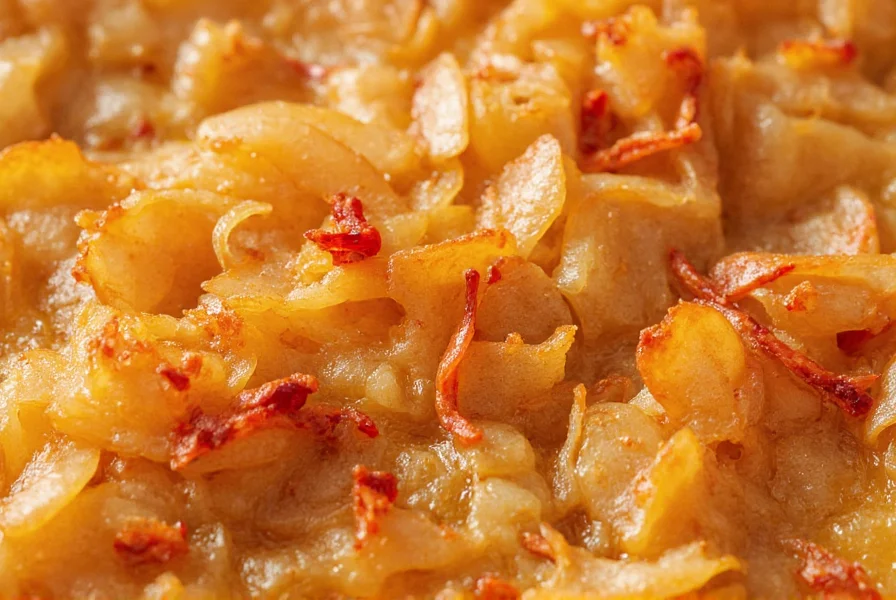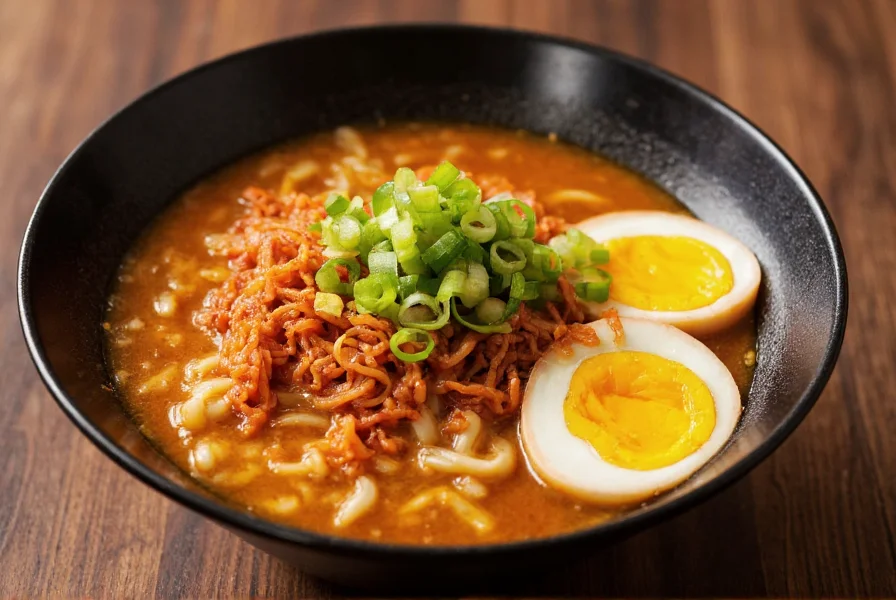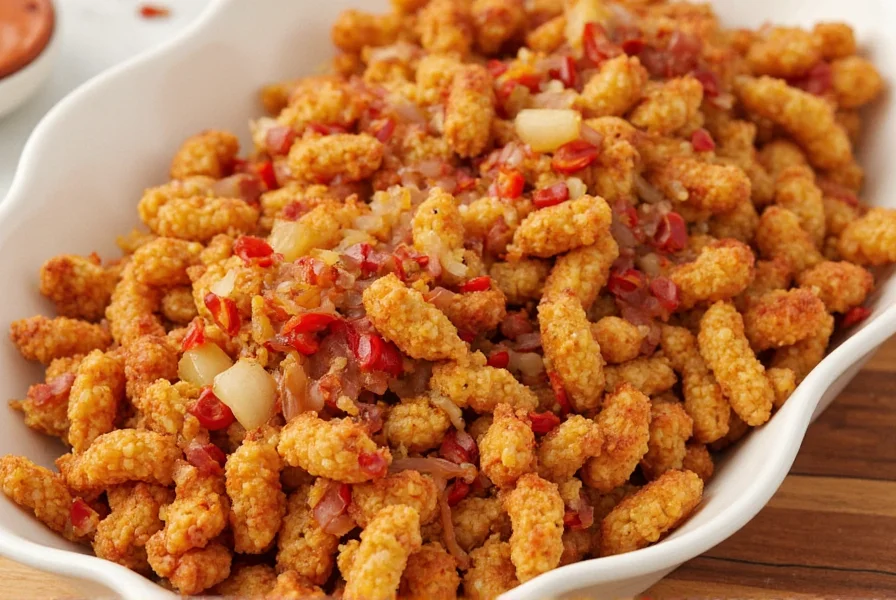Originating from Southeast Asian culinary traditions, chili onion crunch has gained global popularity as a pantry staple for home cooks and professional chefs alike. This vibrant condiment combines crispy fried onions with aromatic garlic, red chili flakes, and neutral oil to create a multi-textured sauce that elevates everything from simple rice bowls to sophisticated entrees.
What Makes Chili Onion Crunch Unique
Unlike smoother chili oils or pastes, chili onion crunch maintains distinct textural elements through its preparation method. The onions undergo a slow frying process that caramelizes their natural sugars while preserving their structural integrity. This creates a delightful contrast between the crispy onion pieces and the infused oil base.
The typical ingredient profile includes:
| Core Ingredients | Function | Common Variations |
|---|---|---|
| Yellow onions | Provides crunch and sweetness | Shallots, red onions |
| Garlic | Creates aromatic foundation | Black garlic, roasted garlic |
| Red chili flakes | Delivers heat and color | Thai chilies, Sichuan peppercorns |
| Neutral oil | Carries flavors and preserves texture | Sesame oil infusion, avocado oil |
Culinary Applications of Chili Onion Crunch
Professional chefs and home cooks utilize chili onion crunch in numerous creative ways beyond its traditional role as a condiment. The best dishes with chili onion crunch include those that benefit from both textural contrast and umami depth.
Consider these innovative applications:
- Stir-fry finishing touch - adds texture after cooking completes
- Marinade component for proteins - creates flavorful crusts
- Salad dressing base - emulsifies beautifully with vinegar
- Breakfast enhancement - transforms simple eggs or avocado toast
- Soup garnish - provides contrast to smooth broths

Chili Onion Crunch vs Similar Condiments
While often confused with related products, chili onion crunch maintains distinct characteristics that set it apart from chili garlic crunch substitute options and other Asian condiments.
Key differentiators include:
- Texture profile - Higher proportion of solid ingredients compared to chili oils
- Flavor balance - More pronounced onion sweetness than garlic-forward alternatives
- Application versatility - Works as both flavoring agent and textural component
- Storage stability - Longer shelf life than fresh herb-based condiments
When exploring chili crisp vs chili onion crunch, note that chili crisp typically contains additional ingredients like fermented black beans, peanuts, or other aromatics, creating a more complex flavor profile but potentially overwhelming delicate dishes.
Practical Usage Tips
Maximize your chili onion crunch recipe ideas with these professional techniques:
- Temperature matters - Add to hot dishes at the very end to preserve texture
- Oil utilization - Don't waste the infused oil; use it as cooking fat for subsequent dishes
- Layering flavors - Combine with complementary elements like lime juice or fish sauce
- Portion control - Start with small amounts and adjust to taste, as intensity builds

Storage and Shelf Life Considerations
Proper storage ensures your chili onion crunch maintains optimal texture and flavor. Follow these chili onion crunch storage tips for best results:
- Store in airtight container away from direct sunlight
- Refrigeration extends shelf life to 3-4 months
- Room temperature storage is acceptable for 4-6 weeks
- Always use clean, dry utensils to prevent contamination
- Check for off odors or mold before use
The oil may solidify when refrigerated - simply allow it to return to room temperature before use. Properly stored, the onions should maintain their crunchiness for several weeks, though gradual softening is natural over time.
Creative Recipe Integration
Expand your culinary repertoire with these chili onion crunch recipe ideas that showcase its versatility:
- Ramen upgrade - Stir 1-2 tablespoons into broth for instant depth
- Roasted vegetable enhancer - Toss with root vegetables before roasting
- Marinade base - Combine with soy sauce and honey for proteins
- Dip transformation - Mix with mayonnaise or yogurt for instant dipping sauce
- Grain bowl accent - Sprinkle over finished bowls for textural contrast
For those interested in homemade chili onion crunch vs store-bought, consider that homemade versions allow customization of heat level and ingredient quality, while commercial products often benefit from professional frying techniques that achieve optimal crispness.
Conclusion
Chili onion crunch represents more than just a trendy condiment - it's a versatile culinary tool that bridges flavor and texture in innovative ways. Whether you're exploring traditional applications or developing new how to use chili onion crunch techniques, this ingredient offers endless possibilities for elevating everyday meals with minimal effort. Its growing popularity reflects a broader culinary trend toward multi-dimensional flavor experiences that engage multiple senses simultaneously.
Frequently Asked Questions
What's the difference between chili oil and chili onion crunch?
Chili oil is primarily liquid oil infused with chili peppers, while chili onion crunch contains significant amounts of solid ingredients - specifically fried onions and garlic pieces suspended in the oil. This creates both flavor and textural differences, with chili onion crunch providing crunch and more complex umami notes.
Can I make chili onion crunch without deep frying?
Yes, you can create a baked version by thinly slicing onions and garlic, tossing with oil, and baking at 300°F until golden and crisp. While the texture won't be identical to deep-fried versions, it provides a healthier alternative with similar flavor profiles. The key is patience - low and slow cooking prevents burning while achieving proper crispness.
Is chili onion crunch gluten-free?
Traditional chili onion crunch made with just onions, garlic, chili, and oil is naturally gluten-free. However, some commercial varieties may contain soy sauce or other additives that include gluten. Always check ingredient labels if you require strictly gluten-free products, and consider making your own to ensure compliance with dietary restrictions.
How can I adjust the heat level of chili onion crunch?
You can control heat by selecting different chili varieties (milder like ancho or hotter like bird's eye), adjusting the amount of chili used, or removing seeds and membranes from fresh chilies. For existing products, balance excessive heat by mixing with additional oil or sweet elements like honey. Remember that heat perception increases over time as the capsaicin infuses.
What are the best store-bought chili onion crunch brands?
Rather than recommending specific brands, look for products with simple ingredients (onions, garlic, chili, oil), visible texture in the oil, and no artificial preservatives. Check for balanced flavor profiles in reviews, and consider regional specialties that might offer authentic preparations. Local Asian markets often carry superior options compared to mainstream grocery stores.











 浙公网安备
33010002000092号
浙公网安备
33010002000092号 浙B2-20120091-4
浙B2-20120091-4